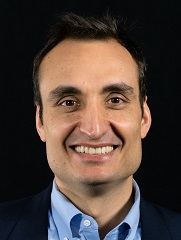University of Rochester: Using telemedicine to reach more patients with Parkinson’s disease
- The University of Rochester began pioneering the use of telemedicine to treat patients with Parkinson’s disease more than a decade ago.
- The initiative started by linking specialists with patients in nursing homes before moving to providing virtual specialty care in the homes of patients.
- Health system leaders, payers and legislators can pave the road to further expansion of such programs through physician training, expanded reimbursement policies and interstate licensure compacts.
Neurological disorders are now the world’s leading cause of disability, and the fastest growing among them is Parkinson’s disease. Each day, 10,000 Americans turn 65, and up to 700 of them will develop Parkinson’s. The number of people with Parkinson’s doubled from 1990 to 2015 and is expected to double again by 2040.


Despite the growing disease burden, access to specialized care is poor, and often nonexistent, for those with Parkinson’s who cannot travel to major medical centers. Over 40% of Americans with Parkinson’s do not receive appropriate neurological care. Those patients face higher odds of falling, breaking a hip, moving into a skilled nursing facility and dying.
The global proliferation of broadband access and smartphone ownership is poised to bridge this gap in access. Telemedicine can reach individuals no matter their location or disease stage. From a cost standpoint, widespread use of telemedicine can reduce health systems’ reliance on expensive brick-and-mortar satellite clinics, eliminate time and travel costs for patients and remove the facility fees imposed on payers for in-person visits.
The biggest cost savings may stem from improved clinical outcomes. A single emergency department visit for a fall and broken hip can amount to $100,000 after factoring in all costs. A telemedicine visit, by comparison, may cost health systems $100 or less. If more frequent and convenient specialized care via telemedicine can prevent a fall in just one in every 1,000 patients, the system already will have paid for itself.
A New York pilot seeks to help afflicted patients
The University of Rochester has been pioneering the use of telemedicine for Parkinson’s disease for more than a decade. Early programs focused on nursing homes in rural New York, where many patients’ disease states were too advanced for them to travel to a specialist, while their locations precluded specialist travel to them.
After showing the feasibility of connecting specialists and institutions via telemedicine on a widespread basis, we began moving care directly into the patient’s home. A series of studies, which resulted in the first randomized controlled trial of in-home telemedicine for people with Parkinson’s, underscored the value, feasibility and acceptability of in-home telemedicine care. Almost all participants in the telemedicine arm completed at least one virtual visit, and overall satisfaction was 97%.
Through generous grants, we then launched Parkinson’s Disease Care New York (PDCNY), the first statewide telemedicine program for Parkinson’s. Providing care for anyone in New York state, regardless of ability to pay, PDCNY has enrolled more than 400 individuals. Of these enrollees, 21% are homebound, 59% are from federally designated Health Professional Shortage Areas and only 50% received specialist care prior to enrollment. Among participants, 94% indicated that they were satisfied or very satisfied with the program.
The program now incorporates educational content and trained therapists throughout the state. As a result, quality of life (as measured by the disease-specific PDQ-39 scale) has improved among participants.
Seeking to expand the program’s scale and scope
PDCNY showed the feasibility of deploying a telemedicine care program for Parkinson’s at scale. However, the program faces constraints in both funding (reliance on grants) and access (only New York residents can receive care).
We will continue to expand in New York and are looking to develop alternative models — for example, an insurance-independent self-payment model; insurance coverage of direct in-home telemedicine; or telemedicine delivered at a clinic near a patient’s home, which is typically paid for by insurance — to sustain the program. We also are broadening outreach efforts to bring care to the most underserved populations, whether based on distance, disability or socioeconomic factors. We will expand to other states through partnerships with major academic medical centers, many of which have the infrastructure and policies to support large-scale adoption of telemedicine.
To broaden our reach further, we need the support of health system leaders, payers and legislators. Making telemedicine a standard component of physician training, as the University of Rochester has started to do, and expanding insurance coverage of telemedicine are essential to provide appropriate care for the growing number of patients with conditions that make traveling for medical care difficult.
Patients living in states with few specialists would benefit immensely from interstate licensure compacts that allow the provision of telemedicine care across state lines. The skill required to treat someone with Parkinson’s in Rhode Island does not change if the patient is located in Georgia, New Mexico or Oregon.
On the most basic level, we must recognize the potential of telemedicine to transform care and improve quality of life for hundreds of thousands of Americans with Parkinson’s and other chronic conditions. Patients are more than ready for this new care paradigm. Are we?





